by Les Harrison | Jul 18, 2015
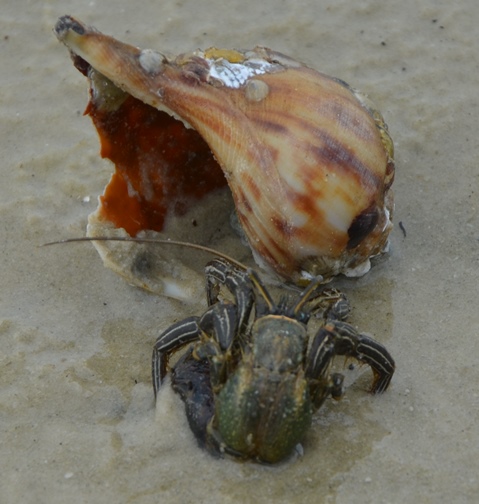
A room with a view: a stripped hermit crab sizes up a potential residence
Summertime in north Florida is good. Among the premium experiences are leisurely hours at the beach.
For many this is a period of relaxation and the opportunity to casually examine what the surf has thrown on the beach. It can be the culmination of a summer vacation or a weekend reprieve from the contemporary insanity of 2015’s workaday grind.
The hermit crab is one commonly encountered native creature which is slow-moving and hard to miss observing. It scuttles along the shallow coastal waters in search of its immediate needs.
In most cases it is the next meal which prompts this member of the Pagurus genus to fitfully crawl about in the borrowed disguise of a gastropod. They are not particular which shell they occupy just so long as it fits their size and is transportable.
Likewise, they are not especially particular about their meals. Hermit crabs are omnivores which relentlessly scavenge for anything digestible in the shallow waters of much of the world.
Their family includes about 1100 members which differ in size, color and housing choices. Some, in other regions, will even lodge in immovable locations and depend on the tidal currents to provide for their nutritional requirements.
When times are good and the hermit crab has plenty to eat, it will outgrow it’s the shell which fate provided for its use. The search for a replacement requires probing, luck and can produce aggressive behavior between hermit crabs if appropriately sized shells are in short supply.
Without the shell a hermit crab is an easy meal for other denizens of the deep. If the shell is too small, the hermit crab cannot grow properly or withdraw into the shell completely which exposes it to the unending stream of predators.
The upper portion of their bodies is covered with a hard exoskeleton, but their abdomen is soft and vulnerable to attack. The long and pliable abdomen is useful for firmly holding to a vacant snail shell which provides the necessary protection.
The technique has proven very successful for the hermit crabs as a whole. Fossil records indicate these crustaceans have existed since the last days of the dinosaurs.
While hermit crabs live alone in the shells they procure, they are commonly found in colonies and compete for a variety of necessary resources and mates. Their collective activity has attracted the attention of many young beach goers.
The small, shy creatures have held unending fascination for generations of children. The hide and seek nature of their behavior retreating into shells at the first appearance of a threat increases the enticement.
The temptation to return home with a unique and diminutive pet has proven irresistible for many. One can only guess how many parents have first learned of their child’s decision by the aroma of a deceased hermit crab.
It is a good thing the visit to the beach is relaxing. To learn more about hermit crabs contact the nearest UF/IFAS Extension Office.
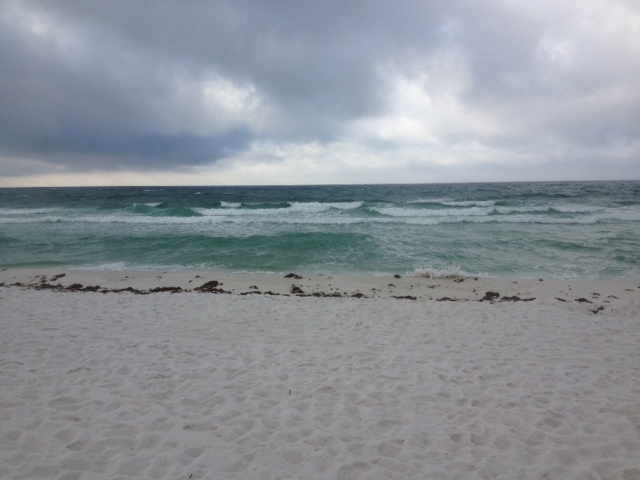
by Rick O'Connor | Apr 17, 2015
As we left the winter months and headed into spring I was expecting a lot of new blooms, new animal tracks, and more live encounters with wildlife… and then the rain began. I do not know if the entire panhandle has been getting what Pensacola has but the rain has been nonstop for over a week now. I track rain days for a water quality project and for the first three months of 2015 the number of days during a month where it rained was between 23-30%. We are about half way through April and so far it has rained 61% of the days. WELL… rain or shine we will make this hike and see what is happening on our barrier island.
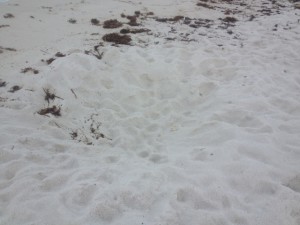
Hole left by a sand castle architect. These can be problems for wildlife and rescue vehicles. Photo: Rick O’Connor
The first thing I noticed when I began the trip along the Gulf was this large hole left by a sand castle architect. These can be problematic for some forms of wildlife, including sea turtles, but they can also be a problem for rescue and turtle watch vehicles. Please enjoy the beach and make awesome sand castles, but when you are finished please fill the hole.
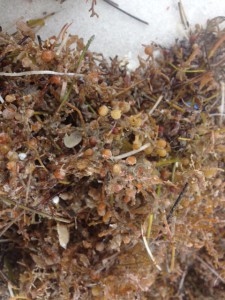
Sargassum is floating form of brown algae. Notice the “air bladders” (pneumatocyst) Photo: Rick O’Connor
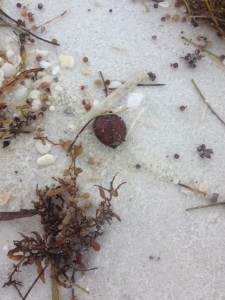
A tropical seed commonly referred to as a sea bean. Photo: Rick O’Connor
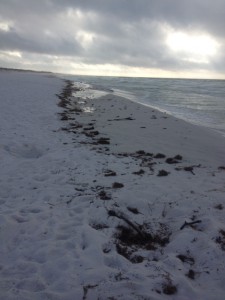
The line of seaweed and debris along the surf zone is called wrack. Photo: Rick O’Connor
The line of seaweed and debris that washes ashore during storms is called the wrack. For the most part it is natural material and provides the nutrients needed for many of the high energy shoreline plants to grow. Many of the beach animals found in the berm and primary dune depend on this wrack as well. Many locals and visitors find this material and eye sore and, at times, producing an unpleasant odor. But this material is an important part of the beach ecology. Sargassum is a drifting member of the brown algae, sometimes called “gulfweed”. It possess small air bladder structures called pneumatocysts that allow it to remain at the surface of the open Gulf where the sunlight is. These large offshore mats of Sargassum have been targets for local fishermen for decades. Many small invertebrates live in these drifting mats and these are targets for small fish, which in turn are targets for even larger sport fish. They are also the hideaway for sea turtle hatchlings. When the little guys head for the Gulf after hatching this is where they are heading. Large ocean currents, including the Gulf Stream, push Sargassum into large mats in the middle of the open ocean. The area within the Atlantic where this happens in known as the Sargasso Sea. If you get a chance this summer, grab a small hand net and mask when the Sargassum is just offshore. Collecting you may find a lot of cool interesting creatures. Sea Beans is a generic word for a variety of tropical seeds that wash ashore in the northern Gulf. Some of these may sprout, including mangroves, but most will not make it through our winters.
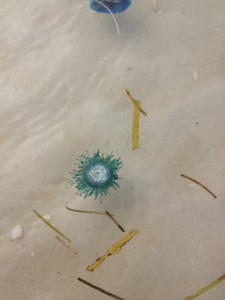
The Blue Button Jellyfish is a tropical cousin of the Portuguese man-of-war. Photo: Rick O’Connor
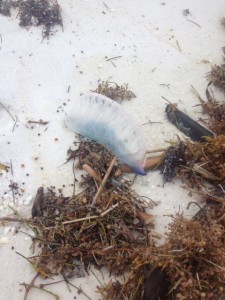
The Portuguese Man-of-War is one of the more venomous jellyfish in Florida waters. Photo: Rick O’Connor.
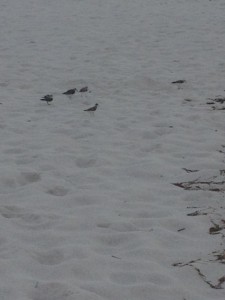
A variety of shorebirds utilize the wrack. Photo: Rick O’Connor
One of the more venomous jellyfish in Florida waters is now making its way onto our shores. The Portuguese man-of-war, named for the many “guns” this animal possess, is well known by locals but not so much by some of our visitors. The man-of-war is actually not one animal but a colony of sedentary polyp jellyfish that produce an inflated bag which floats at the surface carrying them across the sea. The dark blue tentacles hang down into the water column where passing fish are stung and consumed. Each of the polyps have connecting stomachs which helps move the food around to the whole colony. The sting of this jellyfish is quite painful and should be avoided. When they arrive life guards will usually fly a purple flag.
Their close cousins, the Blue Button Jelly, is very similar to the man-of-war albeit they are much smaller and the venom is not as potent. They are more tropical and not common along the northern Gulf but in recent years more have been washing ashore; they are here now.
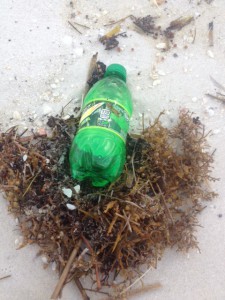
A variety of plastics ends up in the Gulf. Each is a potential problem for marine life. Photo: Rick O’Connor
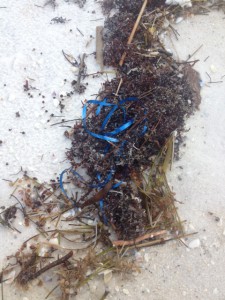
Pieces of plastic ribbon resemble jellyfish tentacles and are frequently consumed by sea turtles. Photo: Rick O’Connor
One of the bigger issues are oceans are facing are discarded plastics. These materials takes years to decompose and are found in all oceans and seas. Even some distant isolated islands have huge piles of this form of marine debris. Plastics can entangle marine organisms or they may actually swallow it, plugging their digestive system and eventually starving them. We encourage locals and visitors alike to help with this problem by taking your trash with you and discarding it in a location where it will not reach the Gulf.
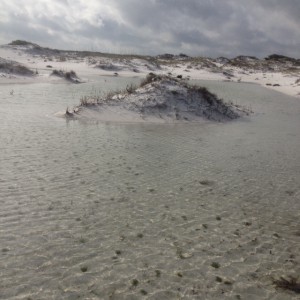
This ephemeral pond formed around a small dune which becomes a temporary island. Photo: Rick O’Connor
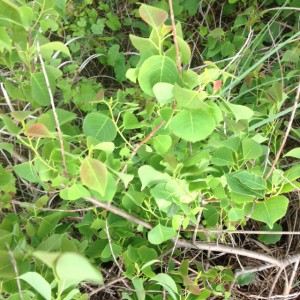
The Chinese tallow is an invasive species the entire state is dealing with. Photo: Rick O’Connor
With the heavy rains of the last week ephemeral ponds have formed on parts of the island. These small pockets of freshwater can be “manna from heaven” for many island residents, particularly the amphibians. I have been hiking this section of Pensacola beach for years, leading field trips for all sorts of groups. I have never seen this Chinese Tallow until today. Also known as the “popcorn tree” due to its unique looking fruit, this plant is listed as an invasive in the state of Florida and is very aggressive. I did not see any others and will seek permission to remove it before it spreads to other dunes and out competes the native plants.

One of the few plants blooming in April, the Spiderwort is a common weed in many lawns. Photo: Rick O’Connor
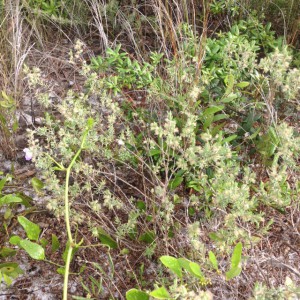
The blossoms of Conradina first appeared in February. They are all but gone this time of year. Photo: Rick O’Connor
I was actually expecting more flowers to be in bloom this month but there were few. The Conradina, which have been in bloom since February, have lost most of its blossoms. The “new kids on the block” are the Spiderwort, the Primrose, the Sandhill Milkweed, and the Devil’s Joint Cactus.
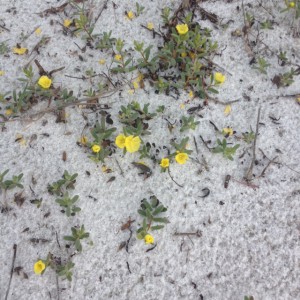
There are a variety of primrose that grow on our barrier islands. They are beginning to bloom now. Photo: Rick O’Connor
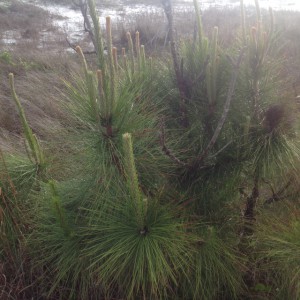
New growth on a pine tree. Photo: Rick O’Connor
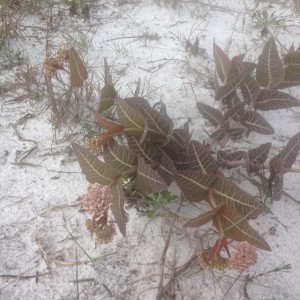
The Sandhill Milkweed. Photo: Rick O’Connor
The Sandhill Milkweed is one of the plants used by the monarch butterfly to gain fuel for their great flight across the Gulf to Mexico. The milky toxic sap of this plant is consumed by the monarch caterpillar but it does not harm it. The chemical toxins therefore become a defense for the monarch and the butterfly has earned the respect of many birds; though it may be a trial and error learning experience.
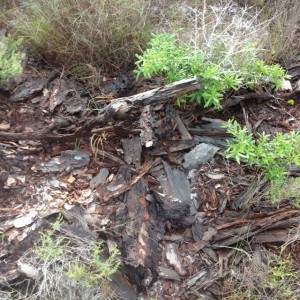
A decomposing log is a microhabitat for many organisms. Photo: Rick O’Connor
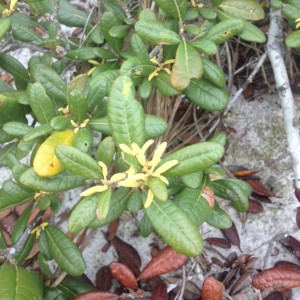
New growth on a live oak. Photo: Rick O’Connor
Most environmental centers, state and federal parks, leave fallen trees where they lie. The tree is actually a storage house of nutrients and full of cavities that can be used by a lot of organisms within the beach community.
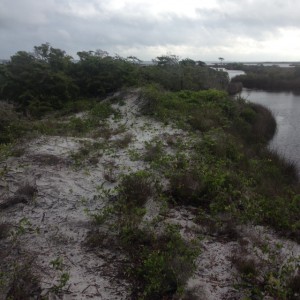
The mysterious “drags” we have seen the last three months were not to be found in April. Photo: Rick O’Connor.
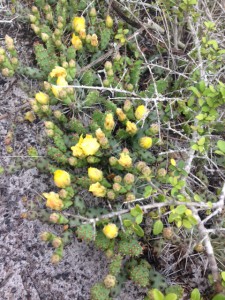
The beautiful yellow bloom of the Devil-Joint cactus. Photo: Rick O’Connor
This month the weather was warm enough for me to venture into the Salt Marsh. Salt marshes are wetlands but differ from swamps in that the dominate plants are grasses, not trees. Our local salt marsh is dominated by two species of grass, the Smooth Cordgrass, and the Black Needlerush. There are many other plants that exist here but these are the most common. This particular marsh is dominated by Black Needlerush. Salt marshes are one of the most productive systems on the planet, producing tons of organic material annually. 90% of the commercially valuable marine species spend part or all of their lives here. There are many unique species to this system as well. Today the water was crystal clear but I saw few fish. I expect as it gets warmer we will see more. It is very possible that with the heavy rains that they have moved to deeper, saltier spots in the Sound.
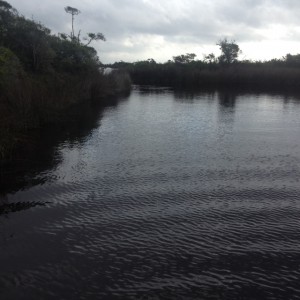
It’s warm enough to enter the salt marsh. Photo: Rick O’Connor
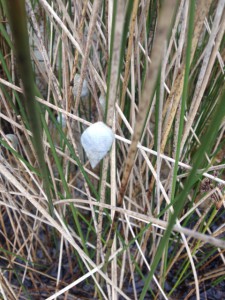
The marsh periwinkle is one of the more common mollusk found in our salt marsh. Photo: Rick O’Connor
The Marsh Periwinkle is an interesting guy. This snail will crawl up the stalks of marsh plants during high tide to avoid predators like blue crab and diamondback terrapins. Both of these predators appear to be on the decline and it will be interesting to see how this impacts the ecology of the marsh. At low tide the periwinkles descend and feed on the organic leaf litter on the muddy bottom.
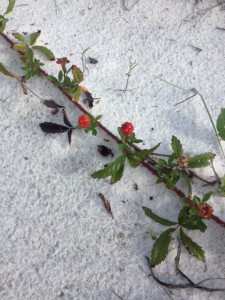
This dewberry has flowered and the dark fruit will be ready next month. Photo: Rick O’Connor

Gracilaria is a common epiphytic red algae growing in our seagrass beds. Photo: Rick O’Connor
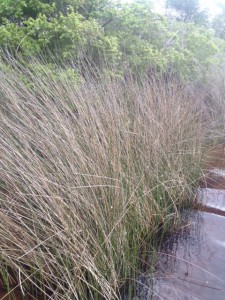
Black Needlerush is one of the two dominant plants of our salt marshes. Photo: Rick O’Connor
Though it has a white appearance, Gracilaria is a member of the red algae group. This algae grows on seagrasses as Spanish moss grows on oaks. The plant is usually kept in check by herbivorous grazers, such as green sea turtles, but in recent decades the number of predators have declined and the amount of nutrient runoff has increased. This has sparked a increase in the growth of this algae and, in some cases, to the determent of the seagrass itself.
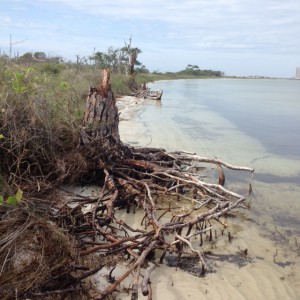
This eroded pine tree gives evidence of the ever changing shorelines of our barrier islands. Photo: Rick O’Connor
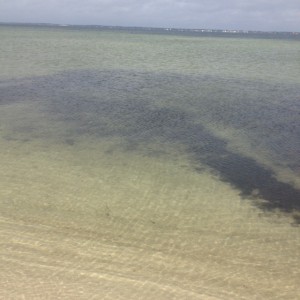
This submerged mound of peat is the remnants of a salt marsh which is now below sea level. Photo: Rick O’Connor
These photos of peat and the eroded tree are indications of a changing shoreline. Due to storms, boat wake, and time, the shoreline of Santa Rosa Island, like all barrier islands, is changing. Peat is actually the remnants of an old salt marsh that has now pass the high tide line and is within the Sound.
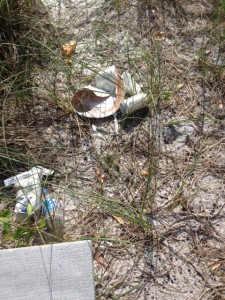
Trash left behind by those enjoying the beach. Photo: Rick O’Connor
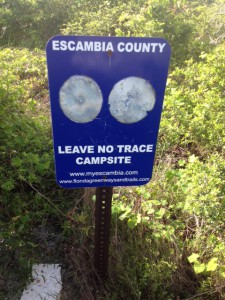
We encourage those who pack it in… to pack it out. Photo: Rick O’Connor
As the weather has warmed and spring break has fallen upon us I have noticed an increase in the amount of trash on this hike, both the Gulf of Sound sides. We encourage locals to take their trash with them and encourage visitors to do the same. Let’s try to keep our waste out of our waters.
I am expecting some animal nesting in May. We will see what we find. Until then.
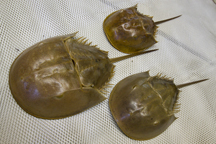
by Rick O'Connor | Apr 10, 2015
These curious ancient animals have been roaming the waters of the Atlantic and Gulf of Mexico for over 450 million years. Though they appear dangerous they are quite harmless and are actually more closely related to spiders and scorpions than crabs. Horseshoe crabs are not as common in Pensacola as they are in Panama City and Port St. Joe areas, but once were once found here and occasionally still are. Many coastal states have been concerned by the decline in their numbers. In the Chesapeake area where they were once very common, horseshoe crabs are harvested for their copper-based blood and also as bait for eel fishermen. The copper-based blood contains lysate which has been used to detect bacterial contamination in many drugs, as well as use for the diagnosis for some diseases.

The ancient horseshoe crab. Photo UF/IFAS Communications
Though there is a fishery for them in Florida, the issue with most locals is just the loss of a really neat animal that has been around longer than the dinosaurs,. This time of year, near the full moon, horseshoe crabs begin to gather near nesting beaches to mate and lay eggs. The Florida Fish and Wildlife Conservation Commission is asking locals and tourists who find a horseshoe crab to report it. They are interested in sightings of both adults and juveniles (less than 4” in length), the date seen, the time, the location, and type of habitat if possible. To report you can visit their website (www.MyFWC.com), email at FWRI@horseshoe@fwc.state.fl.us , or call 1-866-252-9326
If you have any questions contact your county Sea Grant Agent for more information.

by Judy Biss | Mar 27, 2015

Freshwater Jellyfish, Craspedacusta sowerbyi, Lankester, 1880. Photo Credit: U.S. Geological Survey Archive, U.S. Geological Survey, Bugwood.org
Yes, you read the title correctly, it says freshwater jellyfish in Florida! The first time I encountered these unusual aquatic creatures was while swimming in a small lake in southern Indiana. It turns out these jellyfish, while not very common, have been found in almost every state in the U.S. This jellyfish is known as a hydrozoan, a tiny aquatic invertebrate animal. It grows into a few different forms during its life-cycle and is most easily identified when it takes the form of the small jellyfish. This form during its life-cycle is known as a hydromedusa and measures up to about 25 mm in diameter, which is a little larger than a penny.
The scientific name for this unusual organism is Craspedacusta sowerbyi and it is native to the Yangtze River valley in China. It was first described to science in 1880 from specimens collected in water lily tanks in London. This freshwater jelly is now common in temperate climates almost worldwide, and was most likely introduced into the US attached to ornamental aquatic plants and fish.
Hydromedusae, the form that looks like a jellyfish, are produced only sporadically from their otherwise immobile attached form known as a polyp on lake and river bottoms. Sightings of the jellyfish are most common in summer and fall but may go several years between occurrences. The freshwater jellyfish mainly eats tiny aquatic zooplankton, catching them with their stinging tentacles. They are not considered dangerous to humans.
The impact this non-native freshwater jellyfish may have on aquatic ecosystems is not well known. Sightings of this organism are being recorded by the U.S. Geological Survey Nonindigenous Aquatic Species Information Resource and EDDMapS (a web-based mapping system for documenting invasive species distribution, launched by the Center for Invasive Species and Ecosystem Health.)
Based on data from these resources, the freshwater jellyfish, Craspedacusta sowerbyi, has been found in the following north Florida counties: Escambia, Walton, and Washington counties, and in the following peninsula Florida counties: Lake, Hernando, Highlands, Orange, Miami-Dade, Pasco, and Putnam.
So, while you’re enjoying your favorite freshwater swimming hole this summer, keep a sharp eye out for these harmless, fascinating, yet non-native, jellyfish! If you find them, report your sightings here at EDDMaps.
Information from the following resources were used to write this article:
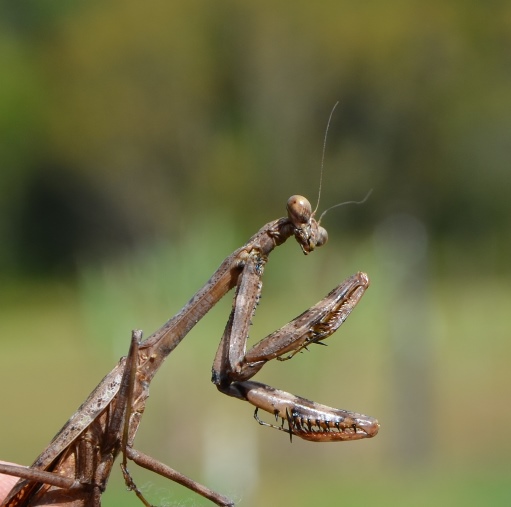
by Les Harrison | Mar 20, 2015

The preying mantis is well equipped to thin the population of destructive insects.
The last two years have been kind to the insect population in north Florida, and 2015 appears to be continuing the trend. The weather has provided enough rain for those bugs which depend on the generous supply of foliage and the temperatures are returning to an agreeable range for population growth.
Stink bugs, leaf-footed bugs, grasshoppers, all sizes of caterpillars and many more are hatching bent on enjoying the lush and plentiful dining selections. Homeowners and gardeners may soon be plagued by the sudden appearance of hordes of hungry pest which are eyeing the menu choices at a residence’s landscape.
Fortunately, nature has a way of equalizing all situations when left to its own devices. With the increase of the plant eaters comes those insects which restrain their population explosions.
One of the most easily recognized predator insects is the praying mantis. This beneficial insect is actually a family with multiple members, some of which have been introduced to Florida.
While there are over 2400 mantis members worldwide, Florida is home to eleven natives. Two of those have been introduced from other regions, but are not considered invasive.
Mantises are thought to have evolved during the Cretaceous period about 100 million years ago, possibly from a predatory cockroach with similar front legs. Their closest surviving insect relatives are cockroaches and termites, both of which they will consume if given the opportunity.
Like many insects, the mantis is equipped with a tough, durable exoskeleton which provides a basis for successful close quarter combat and meal procurement. These hunters have three other advantages which create a severe vulnerability in their prey’s defense and potential for surviving a mantis encounter.
The mantis is an ambush predator which will lay in wait for the victim/meal to deliver itself. The mantis has the instinctive ability to identify and hide in areas with high amounts of prey traffic.
This insect is a master at stealth and camouflage. The creature’s coloration and linear shape allow it to blend into the many natural settings.
To complement this facility to conceal itself in plain sight, the mantis can hold perfectly still and patiently wait for the oblivious animal to bumble into sticking range. At that precise moment, the mantis is a blur of lethal motion.
The mantis’ forelimbs are a set of deadly spiked vices used to immobilize and secure its target. It extends these spiny levers forward in a raised position which appears as though it is in prayer, hence its name.
The intended kill technique is to impale and restrain the victim with a single stroke of the forelimbs while holding the victim securely to the mantis’ body. On occasion the attempt fails and the mantis has to apply a more direct approach.
This insect’s beak is designed for slicing and tearing its victims flesh. The jaws provide the power to effectively employ this means to its meal’s head.
Depending on its stage of life, the mantis will eat a wide variety of creatures. Early stage mantises will eat little flies and other tiny insect (including its siblings), but at maturity they will take on small reptiles and amphibians along with a variety of destructive insects.
Despite its vicious nature, the praying mantis is the soon-to-emerge answer to many gardeners’ prayers.
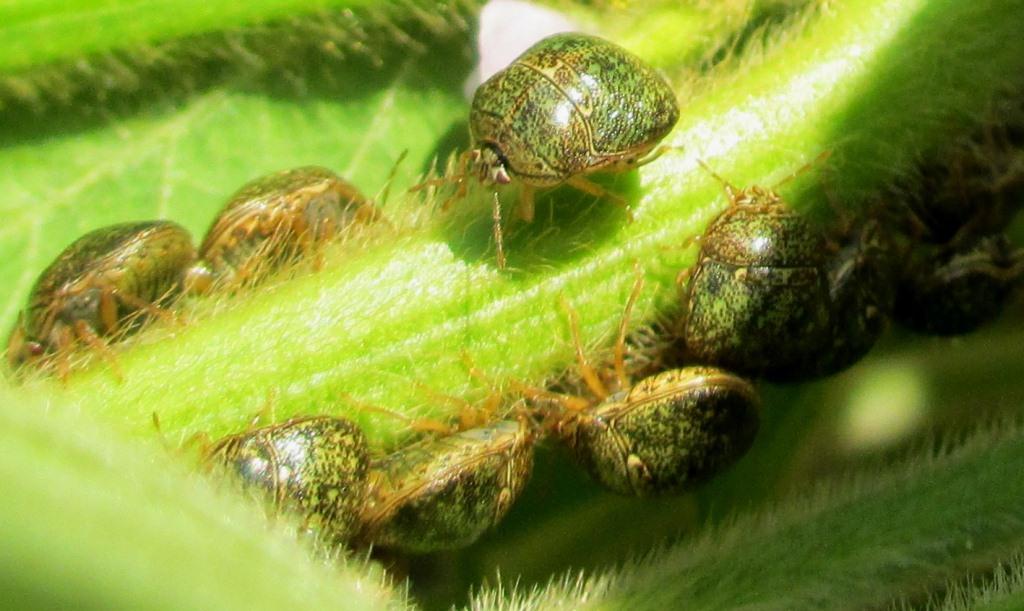
by Jennifer Bearden | Feb 24, 2015
![NISAW-logo09[1]](https://nwdistrict.ifas.ufl.edu/nat/files/2014/02/NISAW-logo091-300x119.jpg)
Kudzu Bug (Megacopta cribraria):
Florida is extending a warm welcome to a new pest! In 2012, the Kudzu bug made its first appearance in our state. And they are settling in to stay. The kudzu bug was first documented in the US in 2009 in Northeast Georgia. It has quickly spread throughout the southeast.
At first, a pest that attacks kudzu sounds pretty good but this bug also attacks wisteria, figs, and other legumes like beans and peas. It is a serious pest to soybeans that are grown in our area. They are similar to stink bugs and discharge an odor when disturbed. Skin and eye irritation can occur from this odor emission.
Kudzu bugs are small (3.5-6mm long), and are rounded oblong in shape, and olive-green in color. They lay egg masses in two rows of 13 to 137 eggs per row. The first generation of kudzu bugs seem to prefer to feed on kudzu but subsequent generations will feed on and lay eggs on other legumes. When fall comes, the adults over-winter where they can find shelter. They crawl under tree bark and into cracks in houses.

Kudzu Bugs feeding on soybean plants in Jackson County. Credit: Doug Mayo
If kudzu bugs make their way into your home, you can vacuum them up and dispose of them. If they are in your landscape or garden, you can set up a trap using a bucket of soapy water and a piece of white poster board. Kudzu bugs are attracted to lighter colors. To make the trap, cut the poster board in half. Attach the two halves by cutting a line up the middle of the two pieces and put them together. They should be in the shape of a plus sign. Place the board over the bucket of soapy water.
Insecticides can be used but timing and placement are very important. Right now, kudzu bugs are just becoming active making now a good time to spray kudzu host plants with an insecticide. Insecticide active ingredients ending in “-thrin” are effective against kudzu bugs. Controlling kudzu near your house will help decrease the number of bugs but they are strong flyers and can migrate through neighborhoods that aren’t near kudzu.
There are some natural enemies of kudzu bugs! Generalist predators like green lacewings, lady beetles, damsel bugs and big eye bugs will attack kudzu bug nymphs. There are also two parasitoids that attack them. A tiny wasp was discovered in 2013 that develops in the kudzu bug eggs. Also in 2013, a fly was discovered that lays its eggs in the adult kudzu bug.
For more information about kudzu bugs, refer to http://edis.ifas.ufl.edu/in939 or go to http://kudzubug.org
Beach Vitex (Vitex rotundifolia):
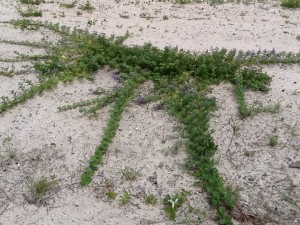
Beach vitex expands its woody rhizomes aggressively; it can actually grow over sidewalks and driveways.
Originally from the Pacific rim of Asia, Beach Vitex was brought to South Carolina to help restore dunes lost during storms. Also known as round-leaved chaste tree and pohinahina, this low-growing shrub does very well in coastal habitats. The plant is a small, deciduous shrub that can grow to a height of 3 feet and forms root and rhizome masses extending over 60 feet from the parent plant. The stems are fleshy when young but become woody with age. The leaves are simple and measure 1 – 2.5 inches in length, are ovate, and dark green on top while lower surface is light green to silver. Locally it flowers in the spring producing beautiful purple to light blue flowers. The fruit forms in mid-summer and are charcoal gray color.
Rapid growth and dense fruit production allows this plant to quickly dominate dune habitats, in some cases covering over 85% of the dune field and crowding out natives such as sea oats. The plant is also known to produce its own chemical weapons to help outcompete native species. Coverage is so thick in some areas the term “beach kudzu” is now being used. Conservation groups believe that this dense growth will negatively impact sea turtle nesting (both for egg laying adults and hatching young). In 2009 the plant was listed on North Carolina’s Noxious Weed List and there is now a statewide task force to combat this invasive. It was first reported in our area on Pensacola Beach. There are 22 known properties on Pensacola Beach and it could very well be found in other panhandle locations. Just recently, beach vitex was listed with UF/IFAS as “invasive not recommended.” If you suspect you have the plant you may contact your local Extension office for information on how to safely remove it. For more information visit www.beachvitex.org
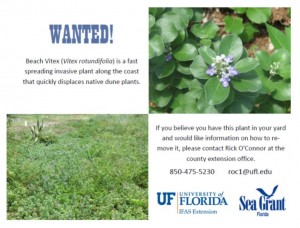
Click to download a “Wanted” Poster to share with neighbors and friends to lessen impact on our native species.
For more information, contact the author Rick O’Connor, UF/IFAS Extension Escambia County, Sea Grant/Marine Sciences Agent 850-475-5230.




































![NISAW-logo09[1]](https://nwdistrict.ifas.ufl.edu/nat/files/2014/02/NISAW-logo091-300x119.jpg)


